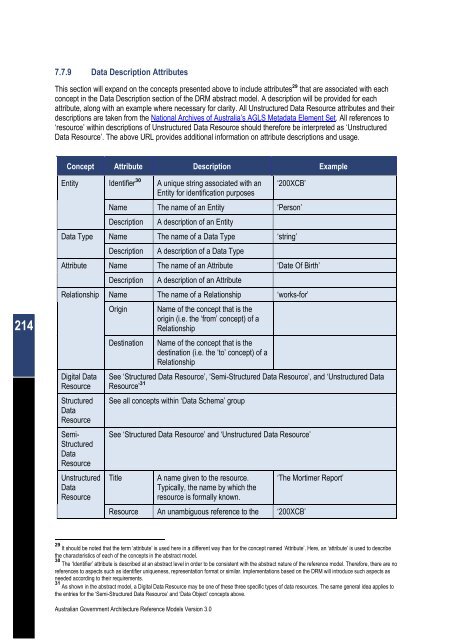Australian Government Architecture Reference Models Version 3.0
Australian Government Architecture Reference Models Version 3.0
Australian Government Architecture Reference Models Version 3.0
You also want an ePaper? Increase the reach of your titles
YUMPU automatically turns print PDFs into web optimized ePapers that Google loves.
214<br />
7.7.9 Data Description Attributes<br />
This section will expand on the concepts presented above to include attributes 29 that are associated with each<br />
concept in the Data Description section of the DRM abstract model. A description will be provided for each<br />
attribute, along with an example where necessary for clarity. All Unstructured Data Resource attributes and their<br />
descriptions are taken from the National Archives of Australia’s AGLS Metadata Element Set. All references to<br />
‘resource’ within descriptions of Unstructured Data Resource should therefore be interpreted as ‘Unstructured<br />
Data Resource’. The above URL provides additional information on attribute descriptions and usage.<br />
Concept Attribute Description Example<br />
Entity Identifier 30 A unique string associated with an<br />
Entity for identification purposes<br />
<strong>Australian</strong> <strong>Government</strong> <strong>Architecture</strong> <strong>Reference</strong> <strong>Models</strong> <strong>Version</strong> <strong>3.0</strong><br />
‘200XCB’<br />
Name The name of an Entity ‘Person’<br />
Description A description of an Entity<br />
Data Type Name The name of a Data Type ‘string’<br />
Description A description of a Data Type<br />
Attribute Name The name of an Attribute ‘Date Of Birth’<br />
Description A description of an Attribute<br />
Relationship Name The name of a Relationship ‘works-for’<br />
Digital Data<br />
Resource<br />
Structured<br />
Data<br />
Resource<br />
Semi-<br />
Structured<br />
Data<br />
Resource<br />
Unstructured<br />
Data<br />
Resource<br />
Origin Name of the concept that is the<br />
origin (i.e. the ‘from’ concept) of a<br />
Relationship<br />
Destination Name of the concept that is the<br />
destination (i.e. the ‘to’ concept) of a<br />
Relationship<br />
See ‘Structured Data Resource’, ‘Semi-Structured Data Resource’, and ‘Unstructured Data<br />
Resource’ 31<br />
See all concepts within ‘Data Schema’ group<br />
See ‘Structured Data Resource’ and ‘Unstructured Data Resource’<br />
Title A name given to the resource.<br />
Typically, the name by which the<br />
resource is formally known.<br />
Resource An unambiguous reference to the ‘200XCB’<br />
‘The Mortimer Report’<br />
29<br />
It should be noted that the term ‘attribute’ is used here in a different way than for the concept named ‘Attribute’. Here, an ‘attribute’ is used to describe<br />
the characteristics of each of the concepts in the abstract model.<br />
30<br />
The ‘Identifier’ attribute is described at an abstract level in order to be consistent with the abstract nature of the reference model. Therefore, there are no<br />
references to aspects such as identifier uniqueness, representation format or similar. Implementations based on the DRM will introduce such aspects as<br />
needed according to their requirements.<br />
31<br />
As shown in the abstract model, a Digital Data Resource may be one of these three specific types of data resources. The same general idea applies to<br />
the entries for the ‘Semi-Structured Data Resource’ and ‘Data Object’ concepts above.

















